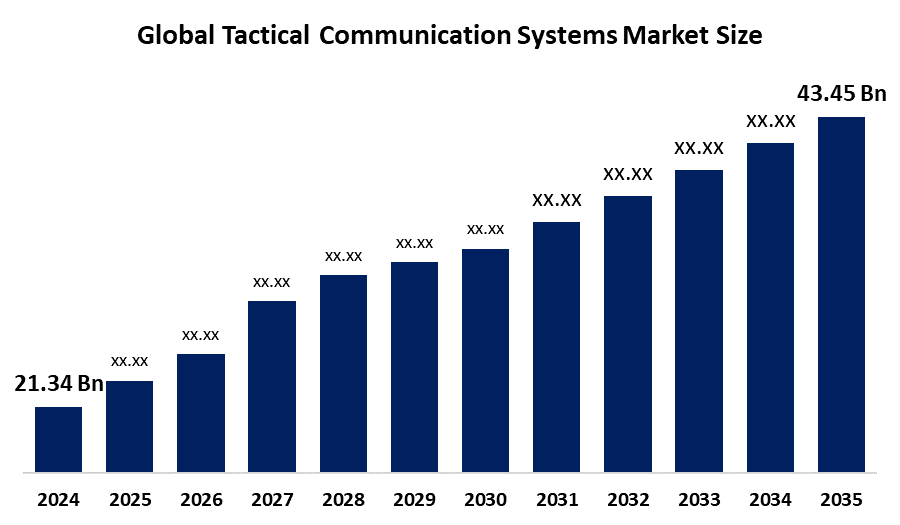
Top 50 Companies in Tactical Communication Systems Market: Statistics Report Till 2035
RELEASE DATE: Sep 2025 Author: Spherical InsightsRequest Free Sample Speak to Analyst
Description
According to a research report published by Spherical Insights & Consulting, The Global Tactical Communication Systems Market Size is projected To Grow from USD 21.34 Billion in 2024 to USD 43.45 Billion by 2035, at a CAGR of 5.62% during the forecast period 2025–2035. All main purchasing regions continue to see demand due to growing defense digitization, growing resources, and a certain shift toward network-centric combat. Although spending is still dominated by hardware, the proliferation of software-defined architectures has led to quicker growth in workstreams that are heavily reliant on integration and training.
Introduction
The capacity of Tactical Communication Systems Market Size to establish and execute efficient networks in the military is the reason for their increasing use for better interaction. The most recent developments, such as digital signal processing and the employment of tactical communication devices in compression technology, are assisting in the fight against miscommunication. Operations can be controlled and directed with the help of integrated tactical communication systems, which are reliable and safe interaction tools. The growing popularity of tactical communication technologies is a result of the various ways that messages can be shared, including orally, in writing, through audio, and visually. These communication methods are becoming more and more popular since they are reliable and safe.
Navigate Future Markets with Confidence: Insights from Spherical Insights LLP
The insights presented in this blog are derived from comprehensive market research conducted by Spherical Insights LLP, a trusted advisory partner to leading global enterprises. Backed by in-depth data analysis, expert forecasting, and industry-specific intelligence, our reports empower decision-makers to identify strategic growth opportunities in fast-evolving sectors. Clients seeking detailed market segmentation, competitive landscapes, regional outlooks, and future investment trends will find immense value in the full report. By leveraging our research, businesses can make informed decisions, gain a competitive edge, and stay ahead in the transition toward sustainable and profitable solutions.
Unlock exclusive market insights - Download the Brochure now and dive deeper into the future of the Tactical Communication Systems Market.
Tactical Communication Systems Market Size & Statistics
- The Market Size for Tactical Communication Systems Was Estimated to be worth USD 21.34 Billion in 2024.
- The Market Size is Going to Expand at a CAGR of 5.62% between 2025 and 2035.
- The Global Tactical Communication Systems Market Size is anticipated to reach USD 43.45 Billion by 2035.
- North America is expected to generate the highest demand during the forecast period in The Tactical Communication Systems Market
- Asia-Pacific is expected to grow the fastest during the forecast period in the Tactical Communication Systems Market.

Regional growth and demand
Asia-Pacific is expected to grow the fastest during the forecast period in the tactical communication systems market. Countries like China, India, and Japan are boosting defense spending to upgrade comms gear, needing reliable systems for tense regional stand-offs. Ongoing issues like South China Sea disputes push militaries to invest in secure networks for quick, coordinated action. Modernization programs are bringing in 5G radios and AI tools to handle drones and complex missions. Tech hubs in South Korea and Australia are pouring money into R&D for faster, encrypted systems.
North America is expected to generate the highest demand during the forecast period in the tactical communication systems market. Modern communications equipment for intricate military operations is funded by the massive U.S. defense budgets, which exceed $800 billion annually. Secure networks that enable quick information sharing and coordination between forces are becoming more and more necessary as homeland security demands rise. With initiatives like the Integrated Tactical Network, the U.S. Army is modernizing and introducing new radios and 5G technology to provide faster battlefield information. Demand for cross-border systems is driven by NATO cooperation and Canada's military upgrading. Leading U.S. research and development continues to produce increasingly intelligent, satellite-connected instruments, solidifying North America's dominance.
Top 5 trends in the Tactical Communication Systems Market
- AI and Machine Learning Integration
- Software-Defined Radios
- 5G Technology Adoption
- Satellite Communication Expansion
- Mobile Ad-Hoc Networks (MANETs)
1. AI and Machine Learning Integration
AI and ML are being woven into tactical communication systems to automatically tweak signals and manage bandwidth. This makes operations smoother and more reliable, especially in high-pressure missions. Defense groups are pouring resources into these smart systems, pushing the market to grow fast.
2. Software-Defined Radios
Software-Defined Radios let users update communication settings without needing new hardware. This saves money and keeps systems flexible for different missions, making them a hit with military buyers. The industry is seeing a surge in demand as forces modernize their gear.
3. 5G Technology Adoption
5G brings super-fast, low-delay connections, letting teams share live data like video or drone feeds instantly. It’s changing how tactical operations work, supporting everything from robots to sensors. Defense sectors are jumping on 5G to stay ahead, driving new tech development.
4. Satellite Communication Expansion
More satellites, especially smaller ones closer to Earth, are giving troops reliable connections in remote areas. This boosts mission-critical tasks like surveillance, increasing demand for portable satellite gear. Companies are investing big in these networks to meet defense needs.
5. Mobile Ad-Hoc Networks (MANETs)
MANETs create self-organizing networks that keep communication flowing even when troops or drones are on the move. They’re perfect for dynamic battlefields, offering flexibility and resilience. Militaries are adopting these systems fast, sparking innovation in rugged, independent networks.
Empower your strategic planning:
Stay informed with the latest industry insights and market trends to identify new opportunities and drive growth in the tactical communication systems market. To explore more in-depth trends, insights, and forecasts, please refer to our detailed report.
Top 25 Companies Leading the Tactical Communication Systems Market
- L3Harris Technologies
- Thales Group
- RTX Corporation
- Lockheed Martin
- General Dynamics
- Northrop Grumman Corporation
- BAE Systems Plc.
- Elbit Systems Ltd.
- Collins Aerospace
- Rohde & Schwarz
- Viasat, Inc.
- Cobham Ltd.
- Curtiss-Wright Corporation
- ASELSAN A.S.
- Iridium Communications Inc.
- Leonardo S.p.A.
- Honeywell International Inc.
- Rafael Advanced Defense Systems Ltd.
- Saab AB
- Ultra Electronics
- Bharat Electronics Ltd.
- Barrett Communications
- Datron World Communications
- Huneed Technologies
- Hanwha Group
1. L3Harris Technologies, headquartered in Melbourne, Florida
L3Harris stands out in the tactical communication systems market with its focus on secure radios and battlefield networks that keep troops connected in tough spots. The company pulls in around $18 billion yearly, much from defense contracts, and offers products like software-defined radios and satellite terminals for real-time data sharing. It's pushing AI integration to make communications smarter, helping militaries adapt faster to threats while reducing gear costs.
2. Thales Group, headquartered in Paris, France
Thales Group plays a big role in tactical communication systems by delivering reliable radios and encryption tech for joint operations across NATO forces. With €18.4 billion in revenue last year, over half from military work, it specializes in handheld devices like the AN/PRC-148 and advanced waveforms for secure voice and data. The firm is ramping up 5G-enabled solutions to boost situational awareness, making it easier for teams to coordinate in dynamic environments.
3. RTX Corporation, headquartered in Arlington, Virginia
RTX Corporation leads in tactical communication systems through its Raytheon arm, providing radars and command networks that link sensors for better decision-making on the ground. The company reports about $68 billion in annual revenue, with strong ties to U.S. defense for products like multiband terminals and CEC systems. It's investing in low-latency links for drones and missiles, which helps cut response times and strengthens alliances in contested areas.
4. Lockheed Martin, headquartered in Bethesda, Maryland
Lockheed Martin excels in tactical communication systems by integrating secure networks into aircraft and ground ops for seamless info flow. Bringing in $67 billion in revenue, mostly from DoD projects, it develops SATCOM gear and ISR tools that support F-35 pilots and command centers. The company is advancing mesh networks for MANETs, enabling resilient comms in jammed zones and driving efficiency for global missions.
5. General Dynamics, headquartered in Reston, Virginia
General Dynamics shines in tactical communication systems with its Mission Systems unit, offering radios and networks that power the Army's WIN-T backbone. The firm clocks $42 billion in yearly revenue, focusing on mobile user systems for on-the-move troops. It's rolling out next-gen waveforms for better bandwidth, which cuts interference and supports unmanned teams, keeping defense budgets in check while boosting field performance.
Are you ready to discover more about the tactical communication systems market?
The report provides an in-depth analysis of the leading companies operating in the global tactical communication systems market. It includes a comparative assessment based on their product portfolios, business overviews, geographical footprint, strategic initiatives, market segment share, and SWOT analysis. Each company is profiled using a standardized format that includes:
Company Profiles
- L3Harris Technologies
- Business Overview
- Company Snapshot
- Products Overview
- Company Market Share Analysis
- Company Coverage Portfolio
- Financial Analysis
- Recent Developments
- Merger and Acquisitions
- SWOT Analysis
- Thales Group
- RTX Corporation
- Lockheed Martin
- General Dynamics
- Northrop Grumman Corporation
- BAE Systems Plc.
- Elbit Systems Ltd.
- Collins Aerospace
- Others.
Conclusion
The Tactical Communication Systems Market Size is growing steadily, driven by rising defense budgets and demand for secure, real-time communication in complex operations. Innovations like AI, 5G, and software-defined radios are enhancing system flexibility and situational awareness. Companies like L3Harris and Thales are leading with advanced solutions tailored for modern warfare. Satellite networks and MANETs are expanding to ensure connectivity in remote and contested areas. The market is set to thrive as militaries prioritize resilient, high-tech communication for mission success.
About the Spherical Insights & Consulting
Spherical Insights & Consulting is a market research and consulting firm which provides actionable market research study, quantitative forecasting and trends analysis provides forward-looking insight especially designed for decision makers and aids ROI.
Which is catering to different industry such as financial sectors, industrial sectors, government organizations, universities, non-profits and corporations. The company's mission is to work with businesses to achieve business objectives and maintain strategic improvements.
CONTACT US:
For More Information on Your Target Market, Please Contact Us Below:
Phone: +1 303 800 4326 (the U.S.)
Phone: +91 90289 24100 (APAC)
Email: inquiry@sphericalinsights.com, sales@sphericalinsights.com
Contact Us: https://www.sphericalinsights.com/contact-us
Need help to buy this report?